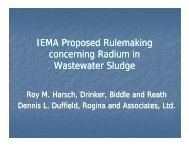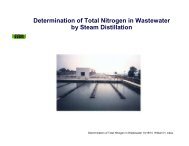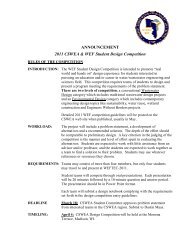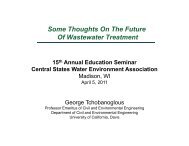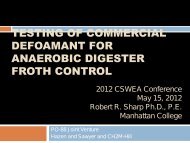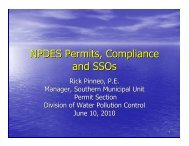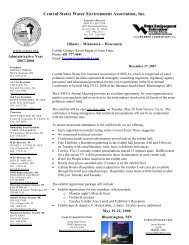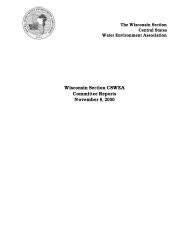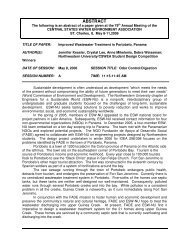Nutrient Criteria - Central States Water Environment Association ...
Nutrient Criteria - Central States Water Environment Association ...
Nutrient Criteria - Central States Water Environment Association ...
Create successful ePaper yourself
Turn your PDF publications into a flip-book with our unique Google optimized e-Paper software.
ABSTRACT INFORMATION SHEET2012 ANNUAL MEETING<strong>Central</strong> <strong>States</strong> <strong>Water</strong> <strong>Environment</strong> <strong>Association</strong>May 14-17, 2011Pheasant Run ResortSt. Charles, ILPaper Title: <strong>Nutrient</strong> <strong>Criteria</strong>: Current Status for the <strong>Central</strong> <strong>States</strong>, TMDL Development and NewTools for <strong>Nutrient</strong> Reduction EvaluationAuthor(s), Title, Affiliation, & Address: (Underline person presenting paper):Brandon KoltzVice PresidentSymbiont6737 Washington St Suite 3440West Allis, WI 53214Will this or similar work have been presented or published elsewhere by the time the AnnualMeeting is held? Yes No xx x If yes, where?______________________________An electronic copy of the abstract should be forwarded to:Rick MannerChair, Technical Program CommitteeUrbana and Champaign Sanitary DistrictP. O. Box 669Urbana IL 61803Telephone: (217) 367-3409 Ext. 230Fax: (217) 367-2603E-mail: rfmanner@u-csd.comFor the use of the Technical Program Committee: Rating* Remarks1. Originality & Status of Subject _______ _______2. Technical Content _______ _______3. <strong>Water</strong> <strong>Environment</strong> Significance _______ _______4. Adequacy of Abstract Preparation _______ _______Total Points _______ _______* 5 = Excellent, 4 = Good, 3 = Average, 2 = Fair, 1 = Poor
<strong>Nutrient</strong> <strong>Criteria</strong>: Current Status for the <strong>Central</strong> <strong>States</strong>, TMDL Development and New Tools for<strong>Nutrient</strong> Reduction EvaluationBrandon KoltzSymbiontIllinois, Wisconsin and Minnesota either have or will be implementing criteria for phosphorus and /ornitrogen. Each state either has or is imposing some point source controls through technology standards.TMDLs are ongoing with respect to attainment of nutrient or nutrient related impairments in all threestates.USEPA has recently made available a web based tool to examine nutrient characteristics in watershedsand at specific locations. USGS has developed an interactive website that utilizes the SPARROW(SPAtially Referenced Regressions On <strong>Water</strong>shed attributes) to predict the nutrient loading fromwatershed units and the subsequent transport downstream. The model has been applied the Mississippiand Great Lakes watersheds as well as watersheds in the northwest, the east coas, and southeast. Theweb application may be used to examine the effect on instream nutrient transport and water qualitycaused by a reduction in nutrient loading from different watershed hydrologic units. In this way, theonline tool is intended as a decision-making tool to assess the efficacy of different source reductionpossibilities.This presentation will provide:A brief overview of status instream nutrient criteria and technology standard development.An example of a discharge permit incorporating water quality based phosphorus discharge limitsfrom WisconsinPotential effect of a TMDL on point source dischargersIllustration of the USEPA’s online water quality monitoring toolIllustration of the online SPARROW phosphorus and nitrogen watershed transport modelA requirement for nutrient reductions will affect many dischargers in the coming years. Knowledge ofpotential requirements and use of available planning tools will assist dischargers in understanding theeffect of their discharge on the receiving stream and downstream receptors, and participate inwatershed planning efforts in an informed manner.



